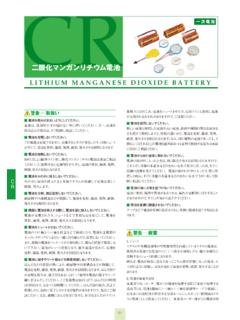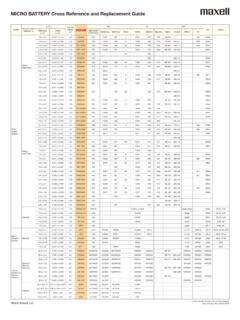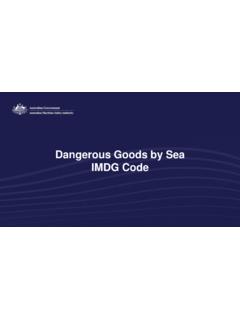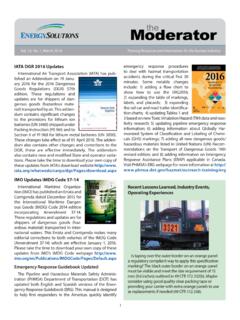Transcription of Update on Dangerous Goods Transportation Regulations for ...
1 Update on Dangerous Goods Transportation Regulations for Lithium-ion cells and batteries January 2017 Some Transportation Regulations have recently been revised. It is important for those involved in shipments of lithium cells and batteries to understand the changes to the Regulations as explained here. Since the information here is a summary of the changes, please use the updated Dangerous Goods Regulations listed in the Normative Reference section to confirm the details. The major revisions for air transport of lithium cells and batteries 1) The specifications of the new Class 9 Lithium Battery hazard label have been added and come into effect as of January 1, 2017. The Class 9 Miscellaneous Dangerous Goods hazard label may continue to be used until December 31, 2018. 2) The specifications of the lithium battery mark have been revised and come into effect as of January 1, 2017.
2 3) An additional document to accompany consignments of Section IB of PI 965, and Section II of PI 965 PI967 are no longer required as of January 1, 2017. 4) The shipper of Section II lithium batteries is required to establish something such as a basic training program to meet the condition for adequate instruction of employees. 5) The following note concerning the lithium battery mark in Section II of PI 967 of IATA s Dangerous Goods Regulations 57th edition , becomes void as of January 1, 2017: Shippers should take steps to implement this requirement as soon as possible, however consignments of more than two packages may continue to move without the lithium battery handling label until December 31, 2016 . Note: Some districts, countries or airlines may establish their own special requirements.
3 Therefore the shipper should confirm with the forwarder in advance. Technical instructions for lithium-ion batteries (PI 965) *1 The words Lithium-ion batteries in compliance with Section II of PI 965 and Cargo Aircraft Only or CAO must be included on the air waybill, when an air waybill is used. The information should be shown in the Nature and Quantity of Goods box of the air waybill. *2 The words Dangerous Goods as per attached Shipper's Declaration and Cargo Aircraft Only or CAO must appear in the air waybill's "Handling Information" column. The major revisions for UN Model Regulations 19th Revised edition 1) The specifications of the new Class 9 Lithium Battery hazard label have been added and come into effect as of January 1, 2017. The Class 9 Miscellaneous Dangerous Goods hazard label may continue to be used until December 31, 2018.
4 2) The specifications of the lithium battery mark have been revised and come into effect as of January 1, 2017. The provisions concerning marking in SP 188 of 18th revised edition may continue to be applied until December 31, 2018. 3) An additional document to accompany consignments in SP 188 is no longer required as of January 1, 2017. The imdg code 2016 edition will contain the descriptions of these UN recommendations. The voluntary compliance date is January 1, 2017. Compliance becomes mandatory on January 1, 2018. Although the Regulations for land Transportation in each country are based on UN recommendations, some districts, or countries may establish their own special requirements. Therefore the shipper shall confirm with the forwarder in advance. Reference Except air Transportation , the minimum requirements to transport lithium cells and batteries as exempted from class 9 Dangerous Goods (non-restricted Goods ) are as follows: 1) Cells and batteries shall be manufactured under a quality management programme.
5 Section IBSection IACell: WhCell: 20 WhCell: 20 WhCell: > 20 WhBattery: WhBattery: 100 WhBattery: 100 WhBattery: > 100 WhCargo aircraft onlyCargo aircraft onlyCargo aircraft onlyCargo aircraft kgN/A10kg35 kgUN specification packagingCargo air craft only labelLithium battery markLithium battery hazardouslabelCargo air craft only labelLithium battery hazardouslabelDeclaration for DGAir Waybill*2 Declaration for DGAir Waybill*2 PackagingStrong rigid outer m drop testLabels(see drawing below)Cargo air craft only labelLithium battery markDocumentsAir Waybill*1 TrainingEstablishment of documented and reviewing these procedures,and maintaining training of DG training and testQuantity of package perconsignmentNo more than 1No limitClassificationExemptedClass 9No limitNet WeightSectionSection IIWatt hourState of Charge (SOC)
6 Not exceeding 30% of rated capacityPackageLimitsQuantityNo limit 2 batteries or 8 cells> 2 batteries or> 8 cells2) For a lithium-ion cell, the Watt-hour rating is not more than 20 Wh. For a lithium-ion battery, the Watt-hour rating is not more than 100 Wh. The Watt-hour rating must be marked on the outside of the battery case except for batteries manufactured before January 1, 2009. 3) Each cell or battery must be of the type proven to meet the requirements of each test in the UN Manual of Tests and Criteria, Part III, sub-section 4) Cells shall be packed in inner packaging that completely encloses the cell. The inner packaging shall be packed in strong rigid outer packaging. 5) A lithium battery mark must be marked on each package. A UN number and a telephone number must be placed on the mark for additional information.
7 6) Each package must be capable of withstanding a m drop test. 7) Except when batteries are installed in or packed with equipment, packages shall not exceed 30 kg gross mass. Maxell will provide certificates for 2) and 3) as the need arises. Documentation for 4) and 5) needs to be prepared by the customer. If our package is used for transport, Maxell will provide the certificate for 6) as the need arises. However, if the customer s package is used, the customer must confirm the package can withstand a m drop test. Furthermore, even if our package is used for transport, the telephone number printed on the mark must be changed to that of the sender (customer). Note: The requirements of the Lithium battery mark does not apply to: Packages containing only button cell batteries installed in equipment (including circuit boards); or Consignments of two packages or less where each package contains no more than four cells or two batteries installed in the equipment.
8 Normative References Major applicable Regulations for the Transportation of lithium cells and batteries are as follows: UN (United Nations) Recommendations (Air, Marine, Overland Transportation ) UN (United Nations): Recommendations on the Transport of Dangerous Goods : Model Regulations 19th revised edition UN (United Nations): Recommendations on the Transport of Dangerous Goods : Manual of Tests and Criteria Air Transportation ICAO ( international Civil Aviation Organization): Technical Instructions for the Safety Transport of Dangerous Goods by Air 2017-2018 edition IATA ( international Air Transport Association): Dangerous Goods Regulations 58th edition Marine Transportation IMO ( international maritime Organization): international maritime Dangerous Goods ( imdg ) code 2016 edition <Drawings of labels> Cargo aircraft only label Lithium battery mark Lithium battery hazardous label * Place for UN number(s) ** Place for telephone number for additional information


















